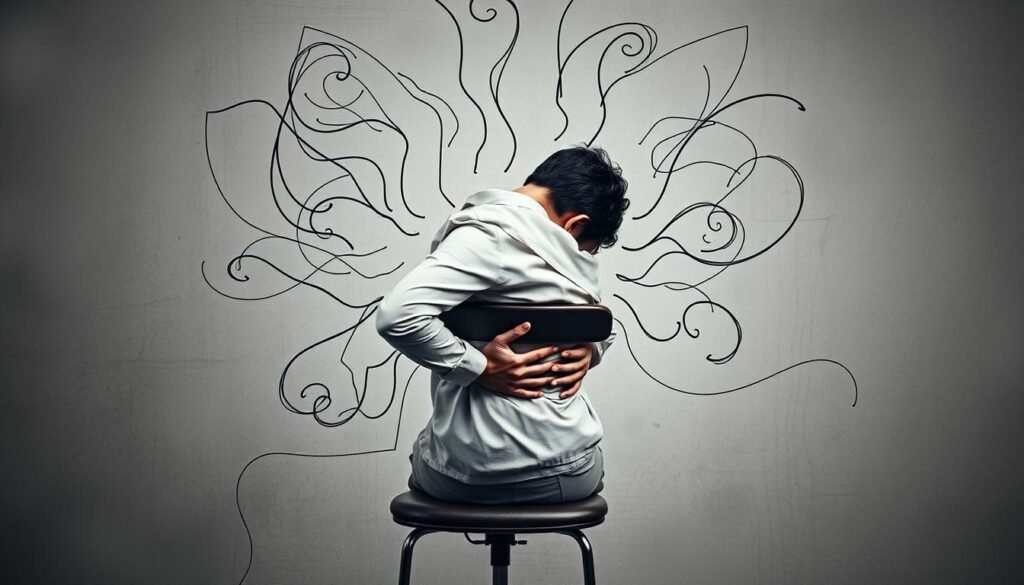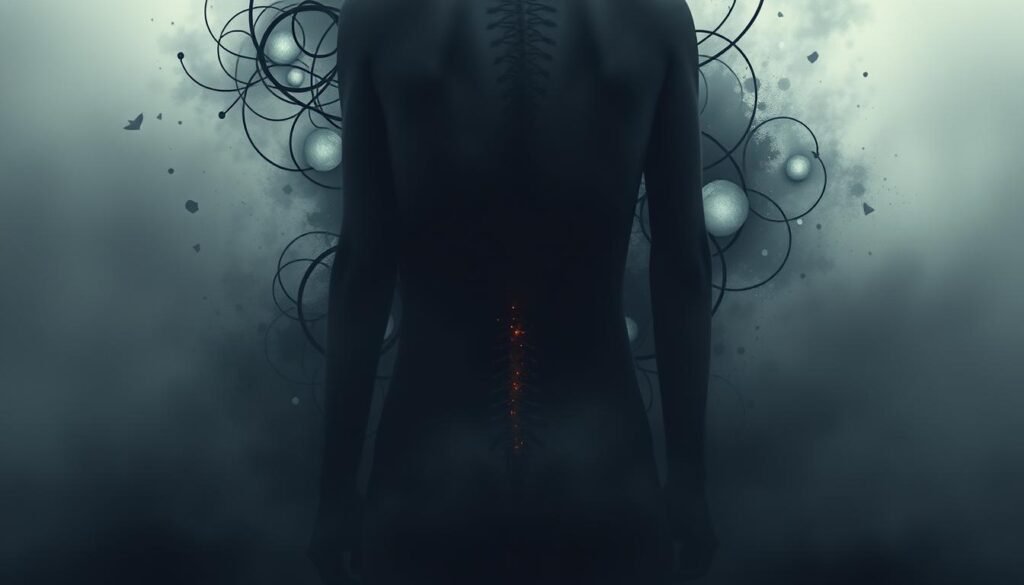Over 500 million people across the globe suffer from back pain. Anxiety can make this worse, even though it’s not always the main cause. For a lot of people, knowing how anxiety-related back pain feels is the first step to feeling better. Anxiety can show up in our bodies, causing ongoing pain that makes everyday life tough.
This guide will look at the different signs of anxiety-related back pain, like tension aches. We’ll also talk about why anxiety makes back pain worse and how to manage it. If you’re interested in how anxiety and physical pain are connected, you’re not the only one. For more information on how anxiety shows up physically, check out Healthline. Or, to learn about symptoms that often get overlooked, visit Mood Care Health.
Key Takeaways
- Anxiety can manifest physically, often leading to noticeable tension back aches.
- Understanding the symptoms of anxiety can improve back pain management.
- Stress from anxiety disorders can increase muscle tension, compounding back pain.
- Practicing effective self-care techniques, such as relaxation and exercise, can mitigate tension back aches.
- Professional help, including cognitive-behavioral therapy, is vital for effectively addressing anxiety and pain relief.
Understanding Anxiety and Its Symptoms
Anxiety disorders are a major global health concern, affecting countless people. They come in different forms. Understanding these can offer insights into their connection with physical pain, such as back pain.
Overview of Anxiety Disorders
Anxiety encompasses conditions like generalized anxiety disorder (GAD), panic disorder, and social anxiety. Although each has unique issues, they share anxiety symptoms. These include lots of worry, feeling restless, and getting irritable. Chronic stress makes things worse by causing muscle tension.
Common Anxiety Symptoms
Knowing anxiety symptoms is key to managing them. Common signs are:
- Muscle tension
- Headaches and migraines
- Fatigue and lethargy
- Difficulty concentrating
- Sleep disturbances
Dealing with these symptoms is crucial. Chronic stress can make muscles tense for a long time. This may cause back pain. So, it’s important for people with these symptoms to get help. Managing anxiety helps avoid chronic back pain.
What Does Anxiety Back Pain Feel Like
Anxiety back pain is quite common among those with anxiety disorders. It feels like tightness, heaviness, or sharp pain in the back. These feelings come from muscle tension and discomfort, known as tension back aches. Knowing these symptoms helps us understand their effect on our daily lives.
Physical Sensations Associated with Anxiety
People often feel various physical symptoms with anxiety, adding to the back pain. Common feelings include:
- Tightness in the upper back, making deep breaths challenging
- Stiffness that may limit the range of motion
- Soreness or spasms that lead to discomfort during daily activities
Muscle tension increases with anxiety. This extra tension can make any pain worse. As a result, psychological back pain is linked to both stress and physical symptoms.
Perceived Intensity of Pain
Pain perception varies widely among people with anxiety back pain. Heightened sensitivity makes many feel the pain more sharply when anxious. This makes sensations stronger and starts a cycle where tension feeds anxiety. Muscle stiffness and soreness are hard to overlook, increasing fear and concern.
The Connection Between Stress and Back Pain
Stress affects our bodies and can lead to back pain. When stressed, we might tighten our muscles without knowing it. This tension can grow over time, causing pain or even chronic conditions.
How Stress Affects Muscle Tension
Stress triggers different reactions in our bodies, especially in our muscles. They tighten when we’re under stress, making us prone to back pain. Studies show stress makes muscles tense, cuts down blood flow, and makes us more sensitive to pain. If this tension keeps up, it can cause lasting back pain, which many find hard to handle.
Stress Back Pain: Common Experiences
There are many ways people feel stress-related back pain. It changes how we feel pain. Here are some common experiences:
- Stress can make the pain worse.
- Many think stiff muscles are just from being tired.
- Along with back pain, some get headaches too.
- It can be tough to keep good posture because muscles are so tight.
Research shows chronic stress might make you 2.8 times more likely to get chronic back pain. Social isolation and ongoing stress can really impact your pain levels. It’s important to manage stress to lessen muscle tension and avoid more pain.
Causes of Anxiety-Related Back Pain
Anxiety affects our bodies in many ways, including back pain. This pain mainly comes from two things: muscle tightness and not moving much, especially when we also sit or stand differently due to feeling anxious. Knowing about these can help manage and ease the pain.
Muscle Tension and Inactivity
Anxiety often shows up as muscle tension, hitting both the upper and lower back hard. This makes the pain feel even stronger because we’re super aware of any ache. Stress often leaves us with tight muscles, as many therapists see in folks dealing with anxiety. Plus, anxiety can make us less active. We skip our usual activities, which only makes things worse for our backs.
Posture Changes Due to Anxiety
How we sit and stand changes when we’re anxious, hurting our back health. Poor posture, along with less movement, invites lasting pain. Feeling on edge can make our neck and shoulders stiff, adding to the discomfort. It’s crucial to pay attention to how we hold ourselves to fight back against this pain.

| Factors | Impact on Back Pain |
|---|---|
| Muscle Tension | Increases discomfort and can lead to chronic pain, particularly in stressed individuals. |
| Inactivity | Reduces physical activity levels, which contributes to discomfort and pain in the back. |
| Posture Changes | Poor posture leads to muscle stiffness and can contribute to long-term discomfort. |
| Hypersensitivity | Makes mild back pain feel more severe, complicating the pain management process. |
| Cycle of Pain and Anxiety | Can create a feedback loop where anxiety exacerbates pain, and pain heightens anxiety. |
The Vicious Cycle: Anxiety and Back Pain
Anxiety and back pain create a tough cycle for many. At first, back pain can cause more anxiety, leading to tension. This tension then makes the pain worse. This shows how pain can make anxiety symptoms stronger, making it hard to manage.
How Pain Amplifies Anxiety Symptoms
Studies show that people with anxiety may feel pain more easily. Even small pains, like back pain, can make fears worse. This makes the nervous system more sensitive, causing chronic low back pain that interrupts daily life. Central sensitization makes pain feel worse than it is, even without injury.
Anxiety Responses to Physical Discomfort
Anxiety can lead to muscle tightness, causing issues like spasms. This creates a cycle of distress, leading to back problems. Not managing anxiety can cause inflammation. This keeps the body in a semi-stressed state called ‘stress-response hyperstimulation.’ It’s crucial to strengthen both physical and mental health to stop this cycle.
| Aspect | Impact |
|---|---|
| Pain Perception | Increased anxiety from minor back pain. |
| Muscle Tension | Leads to chronic discomfort and impaired mobility. |
| Central Sensitization | Normal pain signals become intensified. |
| Stress Responses | Can induce chronic back pain through inflammation. |
| Treatment Strategies | Effective methods include yoga, mindfulness, and physical therapy. |
Understanding the vicious cycle highlights the need for treatment that tackles both mental and physical aspects. Using relaxation, exercise, and therapy can help people break free from this cycle. This leads to better health and less pain.
Psychological Back Pain: A Deeper Look
The link between our minds and back pain is deep and important. Mental health issues like anxiety can shape how we feel pain. Knowing how these affect each other is key to managing pain well.
The Impact of Mental Health on Pain Perception
Mental health shapes how we feel pain. Those with anxiety often feel more pain. Our brains react to stress and worry by making us more sensitive to pain.
This impact of mental health on pain perception can make a cycle. It makes physical pain seem worse, which is hard to break.
Distinguishing Between Psychological and Physical Pain
Telling the difference between mental and physical back pain is tricky. Physical pain comes from clear causes, like injuries or inflammation. But, psychological pain doesn’t have a physical source. Yet, it can still cause real aches or stiffness.
This difference matters when we look for treatments. While both need care, treating mental health can help stop the pain cycle.

Chronic Stress and Its Effects on Back Pain
Understanding chronic stress helps us see how it’s linked to back pain. Chronic stress is the ongoing stress that hurts our well-being over time. It can mess with our body functions, leading to pain, notably in the back.
Understanding Chronic Stress
Chronic stress comes from issues like anxiety, work stress, and big life changes. It makes us worry a lot, causing our bodies to tense up. This tension, and habits like poor posture, can make back pain worse. Actions like lifting heavy things can increase back strain and pain.
The Long-Term Effects of Untreated Anxiety
Not dealing with anxiety can have serious effects on the body. Constant anxiety keeps stress hormones like cortisol high. This can lead to muscle twitching and tension. Over time, it’s harder to handle pain, increasing risks for issues like sciatica and fibromyalgia. It also makes insomnia and tiredness worse, which can make us more sensitive to pain.
It’s vital to handle chronic stress to manage back pain. Things like exercise, meditation, and talking to therapists can help. By addressing chronic stress at its source, we can get better and avoid long-term pain problems.
Managing Muscle Tension from Anxiety
Muscle tension due to anxiety can really affect your day-to-day life. It’s crucial to tackle this tension for better health. Using the right stretching techniques and keeping an eye on your posture can help ease the discomfort from anxiety-related back pain.
Effective Stretching Techniques
Adding effective stretching techniques to your day can help lessen the tension. Here are some great stretches for important muscles:
- Neck Stretch: Gently tilt your head towards one shoulder, holding for 15 seconds on each side.
- Shoulder Rolls: Roll your shoulders backward and forward in a circle, 10 times each direction.
- Hip Flexor Stretch: Kneel on one knee, push your hips forward to stretch your hip front for 20 seconds on each side.
- Child’s Pose: Sit back on your heels with arms stretched forward, holding for 30 seconds to rest the spine.
Posture Awareness and Correction
Good posture is key to fighting muscle tension. Stress often causes bad posture, making back pain worse. Paying attention to how you align your body can help prevent these issues. Here are some posture improving tips:
- Check your workstation setup. Your monitor should be at eye level and feet flat on the ground.
- Activate your core muscles while you stand or sit to keep your spine supported.
- Stand up and stretch every hour to keep your posture in check.
- Use deep breathing and other relaxation methods to ease tension.
Using these effective stretching techniques and paying attention to your posture can greatly lower muscle tension from anxiety. Taking steps towards relaxation is key for finding balance and comfort in your everyday activities.
Anxiety Management Techniques for Back Pain Relief
Managing anxiety helps improve life quality for those with back pain. Anxiety management techniques tackle mental and physical discomfort. They offer a full approach to ease pain and boost well-being.
Cognitive Behavioral Therapy (CBT)
Cognitive behavioral therapy changes negative thoughts related to pain and anxiety. It lets people change harmful beliefs that cause discomfort. This therapy offers new ways to cope, showing its effectiveness in reducing anxiety and pain. Those who try CBT often feel more in control of their back pain.
Relaxation Techniques and Their Effectiveness
Relaxation methods offer big benefits for anxiety-related back pain. Techniques like deep breathing, meditation, and mindfulness promote calm and decrease muscle tension. They help manage stress that can increase pain sensitivity. Adding calming music to these practices boosts mood and aids in handling chronic pain better. Combining these methods with other strategies works well for anxiety management.
Complementary Approaches to Alleviating Anxiety Back Pain
Addressing anxiety back pain often needs several different methods. Regular exercise is crucial for stronger muscles, better flexibility, and well-being. It helps with both physical and mental health aspects. By understanding this, people can make a better plan to manage their pain.
Role of Exercise and Physical Activity
Exercise is key in fighting anxiety and back pain. Studies show that just five minutes of aerobic activity can reduce anxiety. It boosts mood and lessens tension. Activities like yoga, Pilates, or swimming are great. They strengthen the core, increase flexibility, and encourage good posture. These activities help reduce spine pressure, easing pain.
- Reduces muscle tension
- Enhances mood through endorphin release
- Improves overall physical function
- Promotes better sleep quality
Benefits of Massage Therapy
Massage therapy is highly effective against anxiety and back pain. It relaxes tense muscles and improves blood flow. Swedish massage is especially good for anxiety disorder. It is vital in a full treatment plan. Massage does not just help physically but also supports mental health.
- Reduces anxiety levels
- Aids in pain reduction
- Enhances relaxation
- Improves circulation

When to Seek Professional Help
Anxiety-related back pain can significantly impact your daily life. Knowing when to get help is crucial for managing both physical and emotional distress. If pain is persistent or severe, it’s time to seek professional help. Overwhelming feelings of anxiety or hopelessness also mean you should consider getting help.
Signs That Indicate the Need for Treatment
- Persistent back pain that does not improve with home remedies.
- Severe pain accompanied by anxiety symptoms like panic attacks.
- Changes in daily functioning or withdrawal from social activities.
- Emotional distress, such as feelings of despair or constant worry.
- Soreness that worsens despite self-care measures.
If you notice these signs in yourself or someone you care about, it’s time to look into treatment options. Seeking professional help can address the physical pain and help manage anxiety effectively.
Finding the Right Therapist
Finding the right therapist is essential for dealing with anxiety-related back pain. Seek experts in mental health and physical symptoms. Here are some tips when looking for a therapist:
- Credentials: Make sure the therapist is licensed and trained in relevant fields.
- Experience: Choose someone with experience in dealing with anxiety-related conditions.
- Approach: Talk about their therapeutic approaches, like cognitive behavioral therapy (CBT).
- Availability: Make sure their schedule works with yours.
If you’re not sure about the type of anxiety you have, taking an online quiz can help. It helps you understand your anxiety symptoms better and decide on seeking help. Check out this helpful quiz to learn more.
Conclusion
This guide shows how anxiety and back pain are closely linked. It highlights the need to manage anxiety related to back pain well. Many who have chronic low back pain also struggle with anxiety. This can make each condition worse.
A mix of treatments can help break this cycle. Cognitive Behavioral Therapy and mindfulness can lessen anxiety and pain. Adding self-compassion can also improve life and functioning. By treating both mind and body, better outcomes are possible.
In summary, it’s crucial to see these conditions as connected and to address both. This guide suggests steps and professional help to manage them. For those with anxiety and back pain, there’s a study with new insights. It can be found here.